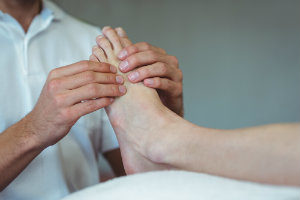


When a toe crosses over and starts to overlap your other toes, it can cause problems. If you are able to identify an issue that can lead to this situation early, you might have a chance at preventing it from happening, or at least worsening. Now, we can provide care for overlapping toes here at the office of Kevin J. Powers, DPM, but you would likely avoid the problem from developing in the first place. Understanding why toes overlap may help you do exactly that.
Generally-speaking, toes start to overlap on account of either muscular or tendon imbalance within a joint. More specifically, this includes conditions like:
It is difficult to overstate the importance of wearing comfortable, well-constructed shoes that fit your feet properly. Choosing the right footwear plays a major role in helping protect your feet and provide much-needed support. That said, there is somewhat of a misconception that shoes actually cause issues like bunions or hammertoes. We certainly agree that poorly-fitting footwear can exacerbate and contribute to an existing foot problem, but the condition usually has roots in a different area. Of course, you can remove any doubt from the matter by always choosing shoes that fit well!
No matter if your overlapping toe is being caused by a bunion or hammertoe condition, we will create a treatment plan to help. For some patients, we are able to do this with conservative treatment options. In other cases, we do need to recommend surgery to address the problem. The good news is that we have ample experience in performing successful procedures for many patients.
Contact us today for more information by filling out our online form or calling our Bloomington, IN foot doctor office at (812) 333-4422 to request an appointment.
The ancient Chinese proverb “a journey of a thousand miles begins with a single step” is still cited frequently in our modern world for a simple reason – it’s completely true. There are few, if any, instances wherein something just happens instantaneously, without at least a certain amount of steps building up to that point.
Whereas the wise saying is often used in terms of achieving goals, it also has relevance in the field of medicine. Many health-related issues start as a smaller problem before traversing that “journey of a thousand miles.” Knowing how to recognize the stages of issues like Charcot foot, however, will help you find the care you need at the earliest, most treatable opportunities to stop the condition’s progression.
Keeping that in mind, let’s look at this particular medical condition. We want you to be able to take the appropriate measures—like contacting our med ical team—at the early stages so you can reduce your risk of developing serious problems.
ical team—at the early stages so you can reduce your risk of developing serious problems.
Charcot foot is a medical condition that may cause severe deformity and disability, especially when left untreated. In severe cases, amputation can be a necessary treatment option, but there is hope if you are vigilant!
Peripheral neuropathy is commonly experienced by diabetic individuals, and this contributes to the problem because you may be unable to recognize when damage has been sustained to weakened foot bones. Further, diabetes compromises your body’s ability to heal injured tissue in a normal, timely manner.
What often happens is an affected individual will fracture foot bones, even during normal activities, but be unaware of it. With healthy nerves, the individual would receive treatment and keep weight off of the foot. Since the damage goes unrecognized, daily activities will continue to be performed. In turn, this leads to additional damage – a cycle which continues until the foot is extremely misshapen and deformed.
Since catching Charcot foot early is so important, you should remain aware for any abnormal redness, swelling, and increased warmth of a foot and ankle (especially when compared to the other one). The actual stages of this syndrome are as follows:
Even more important than knowing these stages, of course, is the action you take once you become aware of a problem. If you do notice Charcot foot symptoms—in any stage—contact our Bloomington office as soon as possible for the professional diagnosis and treatment you need. We will do everything possible to save your foot!
Remember, if you are living with diabetes, you should have a diabetic foot care plan in place. Don’t have one? Then contact us today and we will help you create a plan to protect your feet and reduce your risk of severe medical issues. Call us at (812) 333-4422 and our staff will answer any questions and set you up with an appointment that works for you.